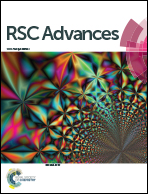Optimization of ultrasonic-assisted extraction of pigment from Dioscorea cirrhosa by response surface methodology and evaluation of its stability†
Abstract
Response surface methodology (RSM) was utilized to optimize the ultrasonic-assisted extraction (UAE) of Dioscorea cirrhosa pigment (DCP). The results demonstrated that the yield of DCP is the highest (32.27%) when acetone volume fraction is 74%, extraction time is 31 min, and the temperature is 54 °C. Next, the effects of pH, temperature, light, metal ions, reductants and oxidants on the stability of DCP were further evaluated to confirm the best storage conditions of DCP. The results showed that DCP should be stored at a wide pH range of 3 to 9, below 80 °C and away from light. Metal ions such as Fe2+, Fe3+, and Ti4+ can destabilize DCP, while K+, Al3+, Ca2+, Cu2+, Mg2+, and Zn2+ have little impact on DCP. Moreover, DCP showed good anti-reduction and poor anti-oxidization properties. These results might provide the basic data and theoretical guidance for the application of DCP.



 Please wait while we load your content...
Please wait while we load your content...